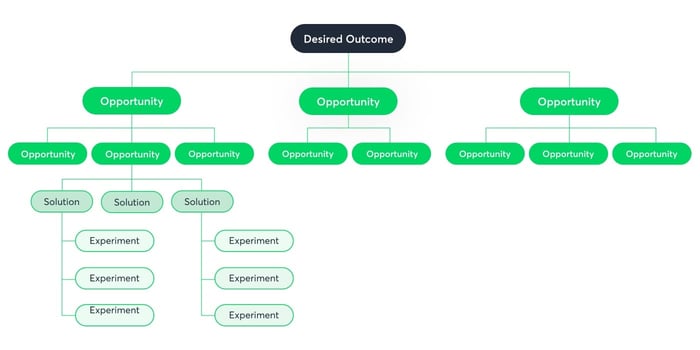How to Reach Desired Outcomes with Opportunity Solution Tree

In this article, we’re going to be discussing how the Opportunity Solution Tree (OST) template can be used to help guide the product management process and enable product managers and designers to visualize opportunities and make decisions with it.
But first of all, what is Opportunity Solution Tree? In simple terms, an OST is a visual aid which helps to guide the product discovery process through non-linear organization of ideation, experimentation and identification of issues or gaps. It’s a visual, step-by-step roadmap to help product teams reach their desired end goal.
If you’re a business leader looking to optimize the products your teams are building, this article will help give you the template to do so, covering:
- What Opportunity Solution Tree Canvas is, and what it looks like
- The problems it can solve and the disadvantages
- How to build your own OST Canvas
By the end of this article, you should have everything you need to integrate Opportunity Solution Tree into your own product development process.
What is Opportunity Solution Tree
To build on the simple definition already given, the Opportunity Solution Tree template was designed to aid product management teams to improve their problem-solving capabilities and reach their desired end goals.
It was first conceptualized by Teresa Torres, a product discovery coach, and attempts to move teams through the steps needed to reach a final solution more methodically. Torres's OST breaks down desired outcomes into opportunities for a product to meet specific user needs and suggests potential solutions to meet these needs along the way.
Opportunity Solution Tree is a solution for the product discovery phase of the product development. Product discovery is a process by which teams conduct discovery exercises, tests and research in order to ensure they create useful, usable products that customers actually want and need.
The OST template or canvas is useful for the product discovery phase because it helps teams prioritize different ideas based on potential quality. Opportunity Solution Tree is a tool that enables product teams to assess whether they have considered all potential avenues to reach the end business goal, then provides clear solutions that can be compared and contrasted to evaluate their value.
This helps to simplify the product discovery phase, making the organization and evaluation of ideas more efficient and thus helping product teams get to a final, ideal product much quicker, therefore improving time to market and reducing resource overheads which can save businesses money. On top of all that, it gives product teams the best possible chance of bringing a product or service to market that consumers will love.
How do you build Opportunity Solution Tree Canvas?
There are a few set steps you can take to build your own OST canvas.
Define your outcome
For any business project to be successful, you need to define what success looks like. Before you begin using your Opportunity Solution Tree, define the end goal you want it to help you reach. Whether you use KPIs, OKRs or some other metrics, make sure the end goal is concrete and quantifiable, so you can actually measure if it has been reached.
You might want to increase customer engagement for example, or achieve better product performance. Either way, don’t go into product development without defining your desired outcome.
Identify opportunities
Once you’ve identified your end goal, you can’t simply jump straight to the solution. You need to take time to conduct generative research. This will help you learn more about potential customers, the product market, the problems customers are trying to solve and more.
Focus on answering each of these questions before filling out this section of the tree. In turn, this will allow you to identify possible opportunitiesto fill into the tree which will then inform the solutions you generate in the next stage.
Generate solutions
Every solution you generate should connect to an opportunity in the previous branch of the OST. Solutions should only be considered if they help you deliver on one of your target opportunities already identified, and if they don’t connect to the tree, they should be considered a distraction.
This phase will involve sharing ideas, with teams collaborating. One of the strengths of Opportunity Solution Tree is that it acts as a single source of truth, helping to encourage people to contribute ideas without worrying about rank, role or experience - as long as solutions are linked to opportunities, they can be entered into the tree.
Iterate and experiment
Select a chosen solution and when you have generated some ideas for it, you can start testing them out. Build a row on the OST specifically reserved for experiments and begin to brainstorm some experiments that will enable you to test the chosen solution, evaluate whether it works and solve any issues that arise along the way.How does the Opportunity Solution Tree Canvas impact the work of a product team?
The process of modern product discovery is a messy one, with lots of back and forth, the swapping of ideas, the mapping of opportunities and the testing of solutions all repeated multiple times, sometimes by different people, until an end goal is reached.
But this can cause chaos and disorganization if the right method of tracking is involved. With so many iterations, it can be hard for teams to connect the customer context (identified in the opportunity phase) with the results of their own solutions (identified, of course, in the solutions phase).
What the OST template does for the work of product teams is help to articulate the link between opportunities and solutions, enabling teams to connect the dots and more easily assess how solutions actually meet the customer needs. It also helps to visualize what a product team learns in a discovery phase and the decisions they take during the process.
These advantages lie in the power of mental representations, which can be described as ‘mental structure that corresponds to an object, an idea, a collection of information, or anything else, concrete or abstract, that the brain is thinking about.
These representations are preexisting patterns of information—facts, images, rules, relationships, and so on—that are held in long-term memory and that can be used to respond quickly and effectively in certain types of situations.’
We can see how this can be mapped onto the work of product discovery teams, especially the part about relationships - between opportunities, solutions and end goals - and so Opportunity Solution Tree is the perfect way to help improve mental representations during this phase, enabling teams to easily prioritize between a backlog of ideas.
The disadvantages of the solution
The main disadvantage of Opportunity Solution Tree is that it requires the input of the whole team and everyone to be involved in the process if it is to be successful.
This helps from a collaboration point of view but it does mean that you need to ensure there is a culture where every individual in the team feels free to bring ideas to the table, otherwise you will be dedicating the resources of an entire team to an ineffective strategy.
Facilitating this culture is the job of the product manager, but also of every team member; each individual needs to buy into the OST process and be willing to share ideas and receive feedback.
The whole process can also be quite complicated, with numerous iterations in every stage or branch of the tree - the danger here is that people on the team will find it easy to communicate simpler solutions. This isn’t always a bad thing but you want to avoid discounting or missing potential solutions just because they are more complicated to communicate.
This all boils down to a question of time; creating and maintaining Opportunity Solution Tree can be time-consuming and difficult to evolve and reflect changes accurately along the way.
An example of Opportunity Solution Tree
Here is a template of Opportunity Solution Tree that can enable product discovery phase.

Source: Miro Opportunity Solution Tree
Describe and visualize the best path to your desired outcome
The product discovery phase can be messy, and it’s hard to connect the dots between the business need, your ideas and the customer’s needs. In simplifying the connection of these points, Opportunity Solution Tree has the potential to really streamline the product discovery phase, getting you to design and release ultimately much faster, and ideally helping your teams to build products which can be successful in the market.
Ultimately the OST is a tool, a visual aid which allows equal involvement from all members of a team, ensuring you are drawing on the broadest range of ideas possible. Finally, the true benefit of Opportunity Solution Tree is that it makes it easier for you to see which user needs and solutions will ultimately bring success to your business.


...%20hero.jpg?width=1200&height=630&name=Jetpack%20Compose%20vs%20Flutter%20(With%20Examples)...%20hero.jpg)




